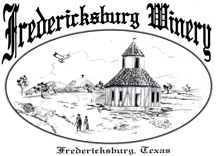|
|

theCompass mobile application is a winery, brewery, and distillery locator for North America. |
|
|
Fredericksburg Winery

|
|
Welcome to the Fredericksburg Winery Website. The Fredericksburg Winery is owned and operated by the Switzer Family. My name is Cord Switzer – I am the guy who will be writing the information. Like everything else at our winery we do it all, this is our personal website no one else is writing this information for me. What is contained on this site reflects our approach – our opinions – our attitude. Everyone is entitled to how they approach winemaking – how they approach life – we have ours and for us it is right.
|
|
|
Directions
View Map
|
View Weather
Baron's Bach Burgundy
Baron's Creek (Baron's Bach in German) on the South and Town Creek on the North were the two natural boundaries of the town of Fredericksburg. The site was chosen by Baron Ottfried Hans von Meusebach, a naturalized citizen of Texas and the United States of America who later changed his name to John O. Meusebach. The settlers names Baron's Creek in his honor. In February, 1845, he succeeded Prince Solms as General Commissioner of the Society for the Protection of German Immigrants in Texas. His academic and practical experience were in geology, natural science, jurisprudence, and national economics. He established a peace treaty with the Indians leading to a substantial trading relationship. Additionally, Meusebach served as State Senator, Justice of the Peace, Postmaster, and Notary of the Public before retiring from public service.
|
Bin 214
The first Bin 214 was the mystery wine from the 1997 harvest. During crush a picking bin of Cabernet Sauvignon had the number 214 but no vineyard name. The grapes were outstanding with a brix of 26.5°. They were used to make our first late harvest Cabernet Sauvignon - all 96 cases. Later, it was discovered the grapes had come from Hoss and LaVerne Newsom's Vineyard on county road 214. We lost Hoss in 2000 - the Switzer family lost a good friend and supporter - the Texas wine industry lost a pioneer and an innovator. This wine is dedicated to Hoss Newsom. In 2001, we finally found that exceptional bin of Cabernet Sauvignon grapes - we think he would approve. In keeping with tradition, we will not disclose what vineyard these grapes came from - only we and Hoss will know.
|
Blue-Winged Teal
Among the first ducks to migrate in the fall and one of the last in the spring, the Blue-winged Teal is known for its speed and agility in flight. Flocks are small, compact and seem to perform their erratic flight maneuvers in unison.
In flight the most distinguishing feature is the large blue-gray upper wing patch which transitions to an iridescent green in the secondaries. The underwing appears almost white. A unique feature of the male (drake) is the white, black edged crescent in front of the eyes contrasting with the slate gray head and neck. Plumage is mottled brown with black speckles and a white spot on the side of the rear. The legs are rustic orange and the bill is gray-black. The female (hen) has a dark brown eye stripe and the bluish coverts are less vibrant than the males. The Blue-winged is rather small in size 12 - 14" long and .8 to 1.1 pounds when mature. A very vocal duck - the male has a soft whistled note and the female a high pitched squeak.
|
Corderillas
On many old maps you will find the valley where the town of Fredericksburg is now located referred to as the Valley of the Corderillas. The range forming the Valley was known as the Corderillas Mountains (in Spanish “Corderillas” means mountain range). Today it is more commonly called the Pedernales Valley.
The microclimate in the Valley is a result of its unique geographic features. Elevations range up to 2,250 feet above sea level and, at a distance of more than 200 miles inland from the Gulf Coast, weather is very moderate. Annual precipitation of 27.44 inches, low humidities, and no smog provide a growing season of approximately 219 days.
This wine has many of the characteristics of a Rhine Wine - spicy in flavor, a crisp clean finish and a good does of fruit acidity on the palate.
|
Der Keller
Sometime the events in the past come to light in the present in strange ways. This is true for the Fredericksburg Winery, which may now have the oldest barrel room in the State of Texas. In July of 1999, it was discovered the cellar (der Keller) used for our barrel storage and aging room had more history than originally thought. It (the cellar) was not built in 1967 when the rest of the building was constructed for the Knopp & Metzger Grocery Store. Instead, it was dug when the Künemann Hardware Store was rebuilt in 1923. The original Künemann Hardware Store was started by Henry and Elsie Dorothea Künemann, but what year, no one has been able to document. Later, two brothers, Arthur and Charles Künemann, bought the store from the remaining family heirs. When Charles passed away in 1945, Arthur bought his interest and operated the Künemann Hardware Store until it closed in 1957.
|
Enchanted Rock
The large impressions in the rock are - according to legend - footprints of an Indian Chief's spirit who angered the gods when (against tribal beliefs) he sacrificed his daughter.
At night, spirit fires dance on the rock to warm phantom warriors of a forgotten tribe who made their last stand here - or, so the story is told. Enchanted Rock has been enchanted and held sacred since before written history.
Enchanted Rock is the second largest batholith in the United States. The exposed portion is only a fraction of the batholith which covers about 90 square miles. A State Natural Area, the Park is located 18 miles north of Fredericksburg. The flora and fauna, geography, and view all add to the enchantment.
|
Freiwilliger
The City of Fredericksburg is blessed with many individuals who contribute to the economic, spiritual and social welfare of the community through their Volunteer efforts. The contribution of their time makes possible the many events which take place in Fredericksburg. They have stood in the wet and cold during Kristkindl Markt and in the heat during Night in Old Fredericksburg. These dedicated individuals have painted floats and their faces to provide the best parades in the State. They have opened their homes for tours and events- but most importantly, they have opened their hearts and selflessly given to this community making it a better place for us all. We, the Switzer Family, Salute you one and all. PROST!
|
IMPACT
Sunday, March 22, 1998, at approximately 7 p.m., the ground beneath the feet of Bert and Cord Switzer moved as they stood in the Old Spanish Trail Research Vineyard. It was suspected at first to be another earthquake similar to the one occurring April 13, 1995, registering 5.6 on the Richter Scale. Later, it was discovered at the very same moment, two meteorites impacted in the city of Monahans, 55 miles to the northwest. It is believed another meteorite impacted even closer to the vineyard but has yet to be uncovered. Whether this astronomic event impacted on the grapes used in this wine cannot be proven - on the other hand, can it be disproved? Whatever the case, enjoy this blend of four different Muscat grapes (Muscat Alexandria, Muscat Canelli, Muscat Hamburg and Muscat St. Vallard) and enjoy the IMPACT of life.
|
Maximilian Sunflower
During the Fall, the creek sides of the Hill Country are alive with the majestic Maximilian Sunflower. Often a towering six feet in height, this perennial has brilliant yellow flowers running the full length of the stem - unquestionably the predominant slower of the Fall season. Growing in colonies or groupings, they have several unbranched upright stems covered with short rough hairs. In drier areas, the Maximilian may reach only one foot in height. The hairy lanceolate shaped leaves alternate and vary from 2” - 10” in length. The composite flower head, 2” - 3” wide are bright yellow with a yellow disk.
|
Rain-Lily
Often a day or two after a rain, between the months of May through September, the Rain-Lily (sometimes called the Evening-Star) will bloom. The white flower has six petal-like lobes usually tinged in pink, where it emerges from the floral tube. The flowers are 1.25” - 2” in diameter, terminal, upright, and solitary on a leafless stem. The leaves, like the flower, emerge from the bulb becoming very elongated, slender, and grasslike. Both the flower and leaves reach up to 12” in height. The C. pedunculata has a floral tube of 1” - 1.5” and blooms more often in the spring and early summer while the C. drummondi (giant Rain-Lily) has a floral tube of 3” - 7” usually blooming in September and October. The flowers, normally lasting 4 days, open in the evening.
|
Skeleton Plant
A slender upright perennial herb appears leafless and therefore its common name. The leaves are usually only at the base by flowering time with the upper leaves reduced to being scale-like. An erect plant, 10” - 24” tall, usually several stems, and sparsely branched, each branch terminating with a flower. The flower head, 1” - 2” in diameter, pink to lavender in color, is actually comprised of 8 - 12 true flowers each appearing as one petal. The ray flowers are square at the tip with 3 - 5 minute lobes. From the center of each rises another tube with a two-part style. Each flower head blooms separately and only lasts for a few hours. The L. texana is a member of the Sunflower Family (Asteraceae) and the bloom period is from April to October.
|
Snow-on-the-Mountain
This very show plant can form extensive colonies covering large areas. August - October is the bloom period. the stiffly upright (12” - 40” height) hairy annual herb often branches in the upper portion into twos or threes. Thirty-five male and one female flowers are congested in a cuplike structure having five white petals. A terminal cluster is formed by several of these flowers and is surrounded by green leaflike bracts with white margins; bracts 2” - 4” long, 1/2” - 3/4” wide are narrower and shorter than leaves. Leaves are alternating. Snow-on-the-mountain is a member of the Spurge family (Euphorbiaceae) which is most noted for the Christmas Poinsettia (E. pulcherrima).
|
Add New Review
|
|